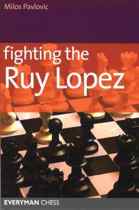Fighting The Ruy Lopez
Milos Pavlovic

It doesnt happen very often but once in awhile two publishers come out with books that cover the same ground without either author having knowledge of the others thoughts. Such is the case with Fighting The Ruy Lopez by GM Milos Pavlovic and Attacking The Spanish by IM Sabino Brunello. The two authors are quite different. The 45-year-old Pavlovic, a former Serbian champion, is a well-known trainer and writer. The 20-year-old Brunello is within spitting distance of Michele Godenas record (2559) for the highest-rated native-born player in the history of Italian chess.
Both authors make the Marshall Gambit (1.e4 e5 2.Nf3 Nc6 3.Bb5 a6 4.Ba4 Nf6 5.0-0 Be7 6.Re1 b5 7.Bb3 0-0 8.c3 d5) the centerpiece of their books, but that is not all they cover. Pavlovic offers a complete repertoire for Black after 1.e4 e5 2.Nf3 Nc6 3.Bb5 with lines not only involving the Marshall accepted but also the Exchange variation (4.Bxc6) and the Center Attack (5.d4 or 6.d4), which are just (or even more) likely to been seen at the amateur level.
Contents
Preface
Introduction: The Ideas Behind the Marshall Attack
Part One: Gambit Lines
The Main Line
The Modern Rook Shuffle: 15.Re4
The Mysterious Retreat: 13.Re2
The Kevitz Variation: 12.Bxd5 cxd5 13.d4
The Dangerous 12.d3
The Tricky 12.g3
Declining the Marshall
Part Two: Anti-Marshall Lines
The 8.h3 Anti‐Marshall
The 8.a4 Anti‐Marshall
The 8.d4 Anti‐Marshall
The Steinitz Variation: 8.d3
Part Three: Other Lines
The Worrall Attack
The Delayed Exchange Variation
Early d4 and c3 Variations
The Exchange Variation
Index of Variations
Brunello offers a much different approach as has written essentially three books in one. Like another Quality Chess work, Beat The Kings Indian by GM Jan Markos, where the Slovak GM offered three different lines to combat the KID, Attacking The Spanish offers the student three gambits each of which has an excellent pedigree having been played by one of the worlds top ten the past year. They include not only the Marshall but also the Schliemann (1.e4 e5 2.Nf3 Nc6 3.Bb5 f5) and the Gajewski variation (1.e4 e5 2.Nf3 Nc6 3.Bb5 a6 4.Ba4 Nf6 5.0-0 Be7 6.Re1 b5 7.Bb3 0-0 8.c3 0-0 9.h3 Na5 10.Bc2 d5).
The Schliemann adopts Teimour Radjabovs favorite 1.e4 e5 2.Nf3 Nc6 3.Bb5 f5 4.Nc3 fxe4 5.Nxe4 Nf6 which he has used successfully against some of the best players in the world. Brunello spends a lot of time on 4.d3, a move that used to be considered a safety-first play by White but has recently come into its own. He points out that Black (read Radjabov) has been fighting to hold on in line 4.d3 fxe4 5.dxe4 Nf6 6.0-0 Bc5 7.Qd3 d6 8.Qc4 and proposes that the rarely played 7…Nd4!? is a better try with “decent chances to equalize.
The Gajewski variation, named for the young Polish GM Grzegorz Gajewski, is yet another example that chess is far from being played out. He only started playing his variation in 2007 but it has caught on in a big way. Brunello devotes 62 pages to the Gajewski, offering both deeply annotated illustrative games and a theoretical analysis covering 11.exd5, 11.d3 and 11.d4. As an aside, those interested in the rapidly changing theory of the Gajewski will want to check out Harvey Williamsens article on it in his series Opening Trends in Computer Chess at Chess Publishing.com.
Close to half of Brunellos book is devoted to the Marshall Gambit and attempts to avoid it (8.d4, 8.a4 and 8.h3). Both books focus exclusively on the Modern Marshall (1.e4 e5 2.Nf3 Nc6 3.Bb5 a6 4.Ba4 Nf6 5.0-0 Be7 6.Re1 b5 7.Bb3 0-0 8.c3 d5 9.exd5 Nxd5 10.Nxe5 Nxe5 11.Rxe5 c6). If you are looking for inferior Marshall Gambit Accepted sidelines like 11…Nf6, go elsewhere.
Examining the two books closely, the following observations can be made. Pavlovic devotes more attention to Anti-Marshall lines and offers more verbal explanation while Brunello gives more analysis of main line Marshall positions. Both books are very good in their own way.
So which book should you get? If you are interested in the Schliemann and Gajewski the choice is clear go with Brunello. Likewise dont think twice if you are a player between 1800 and 2400 who wants a complete repertoire against the Ruy Lopez Pavlovic is your man. Correspondence devotees, players rated over 2400 FIDE and those who are simply dead serious about knowing as much as possible about the Marshall will want both.
